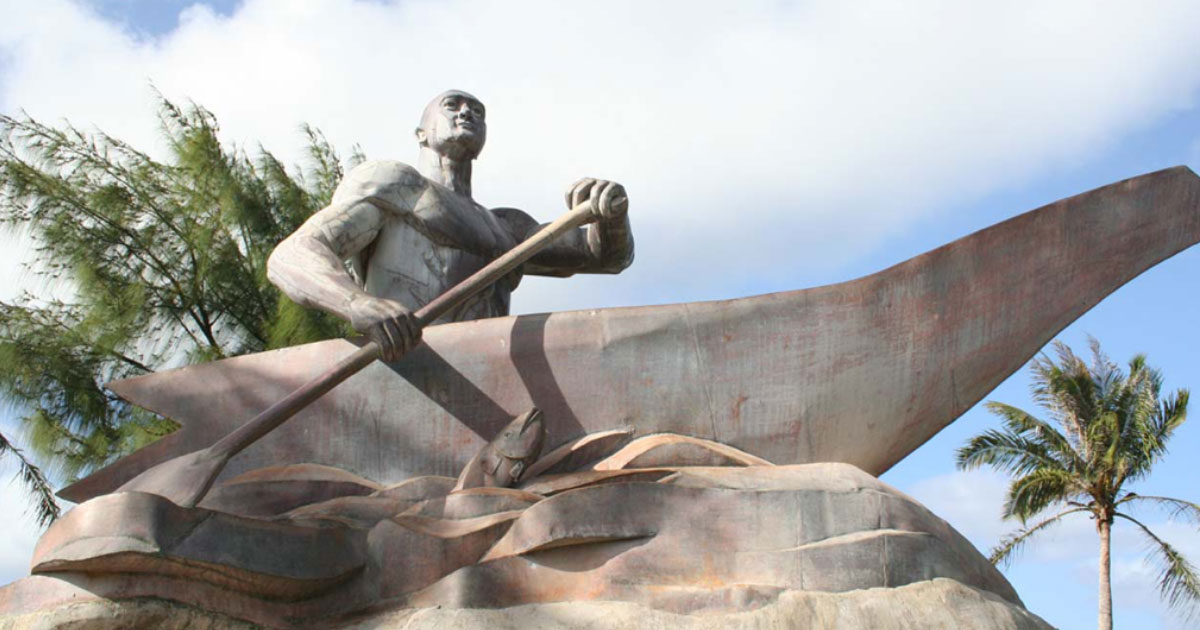Gadao’s Cave, Guam: The Rock Art, The Chief, The Legends
There are many unique cultures with long, fascinating histories in the Pacific Islands and the small island of Guam is a prime example. One of the most renowned sites in the island is Gadao’s cave which is internationally recognized as an important site for rock art and the images here are deeply ingrained in the myths of Guam’s indigenous peoples.
The History of Guam
The island of Guam is located in the Western Pacific Ocean and is considered to be part of Micronesia. The first people to settle on the island came from South-East Asia and they were the ancestors of the Chamorros, the indigenous inhabitants of Guam. Before the coming of the Europeans, the Chamorros developed a highly stratified society which was very sophisticated.

Chamorro People with some traditional dress. (CC BY 2.0)
The Spaniards colonized the island in the late seventeenth century and this led to a dramatic fall in the native population. In 1891 Guam was captured by American forces during the Spanish-American War of 1891. During WWII the island was occupied by the Japanese before it was liberated in the Second Battle of Guam. Today the island is an unincorporated territory of the United States and it hosts a vital US naval base.
Gadao Cave Drawings
The cave is the site of some of the most incredible rock art in the Western Pacific and some of the most important examples of Chamorro art. On two of the cave’s walls are approximately fifty pictographs or images. The paint used to create the pictographs was a compound of lime from coral and the resin from local trees. The pictographs were made by etching lines onto the surface of the cave walls and painting them using the lime compound and all of the images are white.

One Gadao Cave pictogram has become a Guam cultural icon. (CC BY-SA 3.0)
The pictographs are believed to be of people or supernatural figures and they can be likened to stick figures. There are a variety of images including those of animal-like figures, but by far the most popular is that of two men with one of them carrying what looks like a coconut. The pictographs are all between ½ inch (2 cm) and 7 inches (20 cm) in height. The majority of the pictographs of the two men are on the east wall of the cave. Some of the figures on the walls are fairly enigmatic including some mysterious symbols and headless figures.
The Remarkable History of Gadao’s Cave
The rock art in the cave was not studied until the twentieth century. It seemed that rock art was an important part of pre-contact Chamorro culture, because pictographs have also been discovered in other caves in Guam. There is no agreed date for the creation of the images. They could date from the eighth century AD or could have come from the Latte Period when local chiefs were consolidating their power. It was at this time that the Latte Stones were build and they are seen by some as expression of the growing power of the elite. The Latte stones, pillars with spherical heads, are one of the distinctive structures of the island.
- Coral Tombs Housed Royal Micronesians 700 years ago
- House of Taga: Trinian Island’s Unique Megalithic Construction
- Ten Mysterious Examples of Rock Art from the Ancient World

The Latte Stones. (CC BY 2.0)
However, it is possible that some of the rock art dates from the colonization of the island as many believe that some of these pictograms represent a cross or crucifixion. As this is a Christian symbol, it would only have been introduced in the late seventeenth century.
The Legend of Gadao’s Cave
Many experts as well as the local Chamorro have noted the similarities between some of the pictograms and local myths. In particular, the image of two men carrying an object, possibly a coconut, seems to be related to the legend of Gadao. This chief was the greatest warrior and had the reputation as the strongest man on the island, a Guaman Hercules. This irked another chief named Malaguaña and deciding that he would challenge Gadao he went in search of his rival. Along his journey he met Gadao by chance, but keeping his identity a secret, he decided to play a trick on Malaguaña. He promised that he would take him to the strong chief and that he would provide him with a meal after his journey. Gadao began to prepare a meal and he squeezed milk out of a coconut with his bare hands. Malaguaña saw this and he exclaimed that if this man was so strong, imagine how strong his chief must be. The wily Gadao never revealed his name and Malaguaña went home crestfallen. This is only one of several stories about the powerful chief. The cave is named after the legendary chief who may well have been a real-life chief in pre-contact Guam.
Where is Gadao’s Cave?
The cave is near the town of Inarajan which is in the south-west of Guam. It is located not far from a tropical beach and it is a short hike off the road. It is very accessible as a path leads straight to the mouth of the cave, which is not very big. The site is located near a ruined ancient Chamorro village and a statue of Chief Gadao.
Top image: Statue of Chief Gadao Source: Guampedia/ CC BY 2.0
By Ed Whelan
References
Bevacqua, M. L., & Bowman, E. U. C. 2018. Guam. The Contemporary Pacific, 30(1), 136-144
Available at: https://muse.jhu.edu/article/683737/summary
Cunningham, L. J. 1992. Ancient Chamorro Society. London: Bess Press
Diaz, V. M. 1994. Simply Chamorro: Telling tales of demise and survival in Guam. The Contemporary Pacific, 29-58
Available at: https://www.jstor.org/stable/23701589



















